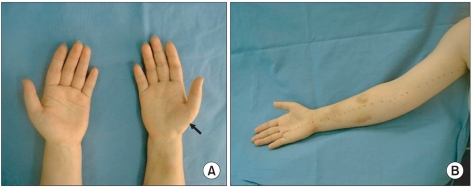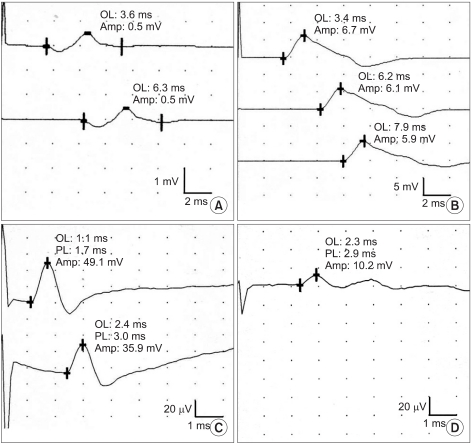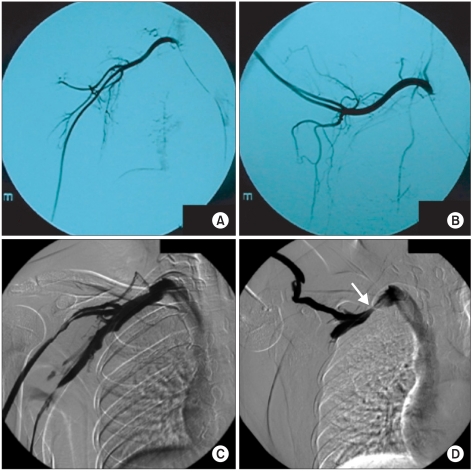Ann Rehabil Med.
2011 Aug;35(4):565-569. 10.5535/arm.2011.35.4.565.
True Neurogenic Thoracic Outlet Syndrome Following Hyperabduction during Sleep: A Case Report
- Affiliations
-
- 1Department of Physical and Rehabilitation Medicine, Korea University College of Medicine, Ansan 425-707, Korea. rmkdh@korea.ac.kr
- 2Department of Thoracic and Cardiovascular Surgery, Korea University College of Medicine, Ansan 425-707, Korea.
- 3Department of Radiology, Korea University College of Medicine, Ansan 425-707, Korea.
- KMID: 1971724
- DOI: http://doi.org/10.5535/arm.2011.35.4.565
Abstract
- True neurogenic thoracic outlet syndrome (TOS) is an uncommon disease and is difficult to diagnose at the early stage and then completely cure. We experienced a case of true neurogenic TOS with typical clinical symptoms and electrophysiologic findings as a result of repetitive habitual sleep posture. A 31-year-old woman who had complained of progressive tingling sensation on the 4th and 5th fingers with shoulder pain was diagnosed of brachial plexopathy at the lower trunk level by electrodiagnostic studies. There was no other cause of brachial plexopathy except her habit of hyperabduction of shoulder during sleep. This case demonstrated that the habitual abnormal posture can be the only major cause of neurogenic TOS. It is of importance to consider TOS with the habitual cause because simple correction of the posture could stabilize or even reverse disease progress.
MeSH Terms
Figure
Reference
-
1. Wilbourn AJ. Thoracic outlet syndrome is over diagnosed. Muscle Nerve. 1999; 22:130–136. PMID: 9883870.2. Yanaka K, Asakkawa H, Matsumaru Y, Kujiraoka Y, Nose T. Diagnosis of vascular compression at the thoracic outlet using magnetic resonance angio graphy. Eur Neurol. 2004; 51:122–123. PMID: 14963388.3. Bun HR, Kim DH, Hwang MR, Kim IJ, Lee JS. Vascular thoracic outlet syndrome with arterial occlusion: a case report. J Korean Acad Rehabil Med. 2007; 31:257–260.4. Shin YB, Sohn HJ, Chang JH, Park HU, Cha YS, Ko HY. Type A botulinum toxin therapy on thoracic outlet syndrome: a case report. J Korean Acad Rehabil Med. 2008; 32:119–122.5. Le Forestier N, Moulonguet A, Maisonobe T, Lcoqger JM, Bouche P, Pierre B. True neurogenic thoracic outlet syndrome: electrophysiological diagnosis in six cases. Muscle Nerve. 1998; 21:1129–1134. PMID: 9703438.
Article6. Cruz-Martinez A, Arpa J. Electrophysiological assessment in neurogenic thoracic outlet syndrome. Electromyogr Clin Neurophysiol. 2001; 41:253–256. PMID: 11441643.7. Kothari MJ, Macintosh K, Heistand M, Logigian EL. Medial antebrachial cutaneous sensory studies in the evaluation of neurogenic thoracic outlet syndrome. Muscle Nerve. 1998; 21:647–649. PMID: 9572246.
Article8. Almeida DF, Meyer RD, Oh SJ. True neurogenic thoracic outlet syndrome in a competitive swimmer: a case report of this rare association. Arq Neuropsiquiatr. 2007; 65:1245–1248. PMID: 18345440.
Article
- Full Text Links
- Actions
-
Cited
- CITED
-
- Close
- Share
- Similar articles
-
- Thoracic Outlet Syndrome
- True Neurogenic Thoracic Outlet Syndrome with Elongated C7 Transverse Processes in a Hemiplegic Patient: A Case Report
- Type A Botulinum Toxin Therapy on Thoracic Outlet Syndrome: A case report
- Cervical Rib Syndrome: 2 Cases Report
- Supraclavicular Approach for the Treatment of Thoracic Outlet Syndrome Due to Cervical Rib: A Case Report




